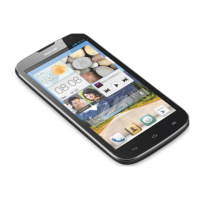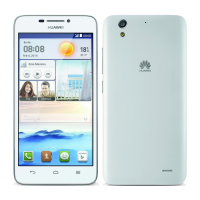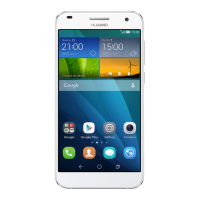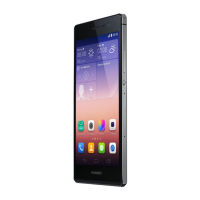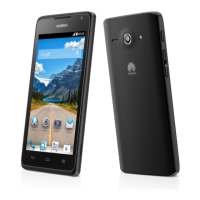Do you have a question about the Huawei Ascend G620S and is the answer not in the manual?
Explains the meaning of icons used in the manual for notes, cautions, and warnings.
Overview of the phone's physical components and indicators.
Guide to inserting micro-SIM and microSD cards.
Instructions for powering the phone on/off and securing the screen.
Using simple movements to control phone functions.
Understanding status bar icons and using the notification panel.
Organizing applications and widgets on home screens.
Changing the theme, wallpaper, and transition effects.
Setting up face unlock, patterns, PIN, or passwords.
Modifying font size and customizing notification panel shortcuts.
Steps for making calls, answering, and using the call log.
Creating, editing, importing, and exporting contacts.
Sending, replying to, and managing messages.
Navigating websites and managing saved bookmarks.
Adding and managing POP3, IMAP, or Exchange email accounts.
Taking photos, recording videos, and managing media files.
Connecting to mobile data and Wi-Fi, managing usage.
Setting up Wi-Fi hotspot and USB tethering.
Managing files and folders on the device.
Downloading, installing, and uninstalling applications.
Optimizing system, power, and backing up data.
Adjusting accounts, display, sound, and network settings.
Setting SIM card PIN and enabling accessibility features.
Information on product trademarks and usage rights.
Legal disclaimers, liability limitations, and privacy information.
Explains the meaning of icons used in the manual for notes, cautions, and warnings.
Overview of the phone's physical components and indicators.
Guide to inserting micro-SIM and microSD cards.
Instructions for powering the phone on/off and securing the screen.
Using simple movements to control phone functions.
Understanding status bar icons and using the notification panel.
Organizing applications and widgets on home screens.
Changing the theme, wallpaper, and transition effects.
Setting up face unlock, patterns, PIN, or passwords.
Modifying font size and customizing notification panel shortcuts.
Steps for making calls, answering, and using the call log.
Creating, editing, importing, and exporting contacts.
Sending, replying to, and managing messages.
Navigating websites and managing saved bookmarks.
Adding and managing POP3, IMAP, or Exchange email accounts.
Taking photos, recording videos, and managing media files.
Connecting to mobile data and Wi-Fi, managing usage.
Setting up Wi-Fi hotspot and USB tethering.
Managing files and folders on the device.
Downloading, installing, and uninstalling applications.
Optimizing system, power, and backing up data.
Adjusting accounts, display, sound, and network settings.
Setting SIM card PIN and enabling accessibility features.
Information on product trademarks and usage rights.
Legal disclaimers, liability limitations, and privacy information.
| Display Size | 5.0 inches |
|---|---|
| Resolution | 720 x 1280 pixels |
| Processor | Quad-core 1.2 GHz Cortex-A53 |
| RAM | 1 GB |
| Internal Storage | 8 GB |
| Expandable Storage | microSD, up to 32 GB |
| Rear Camera | 8 MP |
| Front Camera | 2 MP |
| Battery Capacity | 2000 mAh |
| Operating System | Android 4.4.2 (KitKat) |
| Status | Discontinued |
| Technology | GSM / HSPA / LTE |
| 2G bands | GSM 850 / 900 / 1800 / 1900 |
| 3G bands | HSDPA 900 / 2100 |
| Speed | HSPA 42.2/5.76 Mbps, LTE Cat4 150/50 Mbps |
| GPRS | Yes |
| EDGE | Yes |
| Weight | 160 g (5.64 oz) |
| SIM | Micro-SIM |
| Type | IPS LCD |
| Multitouch | Yes |
| Chipset | Qualcomm MSM8916 Snapdragon 410 |
| CPU | Quad-core 1.2 GHz Cortex-A53 |
| GPU | Adreno 306 |
| Video | 1080p@30fps |
| Alert types | Vibration; MP3, WAV ringtones |
| Loudspeaker | Yes |
| 3.5mm jack | Yes |
| WLAN | Wi-Fi 802.11 b/g/n, hotspot |
| Bluetooth | 4.0, A2DP |
| GPS | Yes, with A-GPS, GLONASS |
| Radio | FM radio |
| USB | microUSB 2.0 |
| Sensors | Accelerometer, proximity |
| Messaging | SMS(threaded view), MMS, Email, Push Email, IM |
| Browser | HTML5 |
| Java | No |
| Colors | Black, White |
| 4G bands | LTE band 3(1800), 7(2600), 20(800) |
| Dimensions | 142.9 x 72 x 8.5 mm |
| Primary Camera Features | LED flash |

